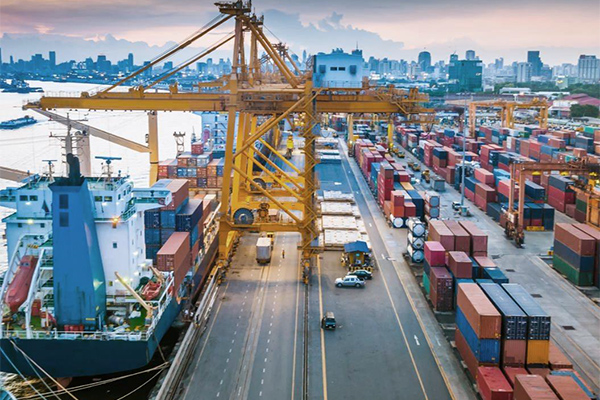Early readings on first-quarter economic activity around the world point to a mild strengthening of momentum. Growth rates in the United States and eurozone were stronger than expected, while Chinese growth remained stable. Yet, the downside risks have once again risen. Both the global manufacturing and services PMIs compiled by IHS Markit for JP Morgan dropped in April, highlighting this fragility. Even more worrisome is the increase in policy risks.
The raising of U.S. tariffs could lead to a damaging upward spiral of trade hostilities and seriously hurt growth. Meanwhile, the escalation of military tensions in the Persian Gulf could push up oil prices more, which would have large negative consequences for global growth.
United States: A strong start to 2019. The advance estimate of first-quarter US GDP growth was reported at 3.2%, up from 2.2% in the fourth quarter of last year and in line with the 3.0% rate of increase averaged over the four quarters of 2018. The robust first-quarter pace is expected to be temporary, as it was driven by two sources of strength that could easily reverse in the second quarter: inventory investment and net exports.
A better indicator of economic health is final sales to private domestic purchasers, which decelerated in the first quarter to the slowest rate of increase in nearly six years (1.3%). We expect real GDP growth to moderate beginning in the second quarter, and we look for a 2.7% rate in calendar year 2019. We predict annual growth will decelerate to 2.1% in 2020 and 1.8% in 2021. The recently announced tariff increases by the United States and China will further erode growth—a lot further if the trade war intensifies.
Europe: Better than expected. The flash estimate showed eurozone real GDP increasing 0.4% quarter on quarter (q/q) in the first quarter of 2019, double the pace of the final two quarters of 2018. Year-on-year (y/y) growth leveled off at 1.2%, well below the cyclical peak of 2.7% in the third quarter of 2017. Available data suggest private consumption benefited from moderating energy inflation rates, resilient employment, and higher compensation growth. The drag from net trade appears to have eased, with export growth improving somewhat. Eurozone real GDP growth is projected to slow from 1.8% last year to 1.2% in 2019 and 1.1% in 2020, before edging up to 1.2% in 2021. Meanwhile, the uncertainty about Brexit continues, as the decision deadline has been extended to the end of October. The UK economy will lose some momentum in the second and third quarters, as the stocking up that boosted first-quarter real GDP growth to 0.5% q/q unwinds.
China: Steady growth—but the economy is not out of the woods yet. China's economic growth held steady at 6.4% y/y in the first quarter, helped by rebounds in the industrial sector and exports. Unfortunately, China's economy is not out of the woods yet. Viewed on a q/q annualized basis, real GDP growth has decelerated steadily from 7.4% in the second quarter of 2017 to 5.7% in the first quarter of this year. Moreover, the first-quarter stabilization was largely due to surging exports, mostly to the European Union and the Association of Southeast Asian Nations (ASEAN). The sustainability of the export rebound is questionable—in fact, exports fell in April. An even bigger risk is the recent increase in US tariffs on Chinese exports, which will lower growth by about 0.2 percentage point this year and next. The Chinese government has gradually ramped up fiscal and monetary stimulus to support growth—and will do more if needed. Real GDP growth is projected to slow from 6.6% in 2018 to 6.2% this year and 5.9% in 2020 and 2021.
Other large emerging markets: Hazards galore. Even as the global economic environment looked as if it would be improving for emerging markets (slightly stronger growth and easier monetary conditions) political and policy risks have risen sharply. This is bad ne.ws for the world economy, and especially emerging markets. The re-escalating trade conflict between the United States and China will damage growth, both directly and indirectly. Higher US tariffs and Chinese retaliation will directly hurt growth in the economies of the two antagonists. This, along with disruptions in supply chains, will drag down growth in the emerging world. The indirect effects will include hits to the stock markets and currencies of the most vulnerable economies.
“Against this backdrop, investors have no shortage of other anxieties (some new and some old), including a bad combination of politics and economics (recessions) in Argentina and Turkey, as well as a dangerous escalation of the conflict between Iran and the United States,” says IHS Markit from Chief Economist Nariman Behravesh
Bottom line: Growing political and policy threats mean any rebound in global growth could be ephemeral.
SC
MR


Latest Supply Chain News
- Israel, Ukraine aid package to increase pressure on aerospace and defense supply chains
- How CPG brands can deliver on supplier diversity promises
- How S&OP provides the answer to in-demand products
- AI, virtual reality is bringing experiential learning into the modern age
- Humanoid robots’ place in an intralogistics smart robot strategy
- More News
Latest Podcast

 Explore
Explore
Business Management News
- How CPG brands can deliver on supplier diversity promises
- How S&OP provides the answer to in-demand products
- AI, virtual reality is bringing experiential learning into the modern age
- Tips for CIOs to overcome technology talent acquisition troubles
- There is still work to do to achieve supply chain stability
- Blooming success: The vital role of S&OE in nurturing global supply chains
- More Business Management
Latest Business Management Resources

Subscribe

Supply Chain Management Review delivers the best industry content.

Editors’ Picks





